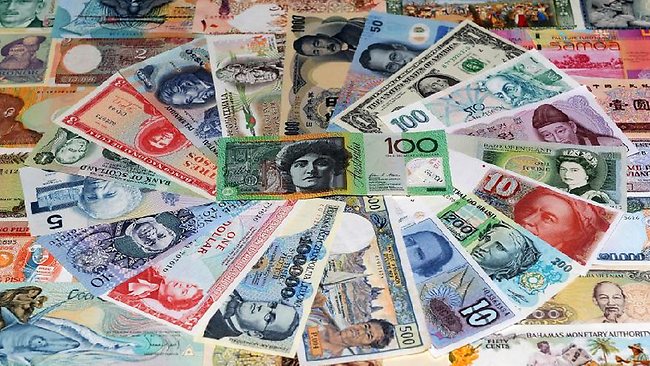Last week, the Liberian government announced it had lost $104m (£79m). This wasn’t through any bad investment decision or some accounting fraud, the money – in cash – had literally gone missing.
The banknotes had been ordered by Liberia’s central bank from printers overseas and had disappeared after passing through the country’s main port and airport. The government is now investigating.
Meanwhile, last month Indians expressed outrage on social media about printing money.
A report in the South China Morning Post claimed the state-owned China Banknote Printing and Minting Corporation had won a contract to print Indian rupees, prompting concerns about national security.
India’s government denied this, saying it was “baseless” – it actually prints all its currency in four high-security presses.
But both these cases have raised the question of whether we should care where our money is printed.
Is it common practice?
Some countries, like India, do manufacture all their cash at home. For example, the US is legally obliged to print its banknotes within its territories.
But for most it’s actually a common practice to print some of their money abroad, while others like Liberia don’t even have their own mint.
A number of highly specialised companies make cash for most of the world’s currencies. Banknote producer De La Rue estimates the commercial print market makes up 11% of all banknotes produced.
The largest banknote producers are mostly in Europe and North America. British company De La Rue, which lost out on a contract to print the new blue UK passport this year, is the largest banknote manufacturing company worldwide. It produces cash for about 140 central banks. Every week it produces enough notes that if stacked up would reach the peak of Everest twice.
Its competitor, German company Giesecke & Devrient produces notes for roughly 100 central banks, while the Canadian Banknote Company and US and Sweden-based Crane are also major players.
Although it’s a big business, it’s a somewhat secretive business too. The BBC contacted a number of money manufacturers, all of which refused to disclose exactly which central banks they produce money for. Many governments don’t like to talk about it either.
It’s perhaps understandable given the anger in India, which shows the sensitivities that some people have about where their currencies are printed.
“It becomes an issue of nationalism,” says Duncan Connors, an expert in the history of money at Durham University.
Why don’t countries do it themselves?
Basically, it’s expensive and difficult to do. The companies involved in printing notes have been in existence for a few hundred years. They have specialist technology and developed credibility on security.
De La Rue began producing banknotes in 1860, first for Mauritius and then elsewhere. It manufactures the new polymer Bank of England fivers and tenners.
For smaller countries it can make a lot of sense to outsource production. It may not be worth purchasing expensive presses if they only need a small number of notes. It would also require keeping up with fast-moving technological advances to prevent counterfeiting.
A banknote printer produces about one to 1.4 billion notes a year. So if a central bank produces less than that it’s not really worth it financially. The US prints approximately seven billion notes per year.
The small pacific nation Solomon Islands, which has a population of 600,000, has its currency designed and printed by De La Rue. Other publicly available information shows that Macedonia and Botswana also outsource to the British company.
Is it risky to outsource this?
Many concerns in India were based on national security issues, especially as the country is currently engaged in a border dispute with China.
But are fears on outsourcing money production fair?
A striking example is Libya in 2011. The UK government withheld about 1.86bn dinars (£929m), some £140m of which had been printed by De La Rue, causing a banknote shortage in Colonel Muammar Gaddafi’s last moments in power.
So in some instances a foreign government could withhold cash, but it’s rare. The Libya incident shocked industry experts but didn’t have much impact on outsourcing banknote production.
Theoretically, a country could be undermined by outsourcing production if the manufacturer printed more than was asked for, without the permission of a central bank, oversupplying an economy with cash. That could have an undesired effect on the economy, such as inflation.
There’s also the risk that a foreign power printing money would have the knowledge of the security features of a particular banknote, making it possible to produce fraudulent notes.
However, there is no visible evidence to suggest that either of these examples currently take place.
There is an issue though of trust in countries with high levels of corruption printing their own currencies. “Do you trust people in your own country to print your own money?” says Mr Connors.
However, given that most currency is still printed by countries themselves perhaps the threat is not that big.
“The majority of countries print their own banknotes and a small amount are printed with commercial industry,” says Guillaume Lepecq, director of the International Currency Association.
There is no international body for regulating money production.
Will we need cash in future anyway?
Lots of people are using cash less often. Apps and contactless payment methods have made it easier than ever not to use notes.
The People’s Bank of China says only 10% of payments in retail were made in cash in 2016 due to the rise of mobile payments.
Despite this, according to industry experts Smithers Pira, the demand for banknotes around the world continues to grow. It estimates year-on-year growth to be at 3.2% for the global market, which is currently worth just under $10bn (£7.6bn). Asia and Africa are the fastest growing regions for banknote printing.
So we’re not post-cash, yet.
Source: BBC News






